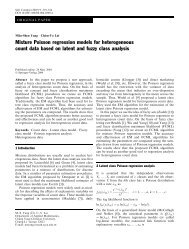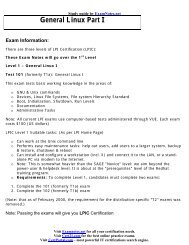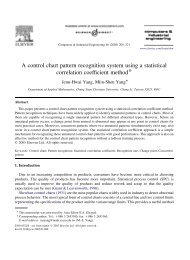A novel fuzzy clustering algorithm based on a fuzzy scatter matrix ...
A novel fuzzy clustering algorithm based on a fuzzy scatter matrix ...
A novel fuzzy clustering algorithm based on a fuzzy scatter matrix ...
Create successful ePaper yourself
Turn your PDF publications into a flip-book with our unique Google optimized e-Paper software.
K.-L. Wu et al. / Pattern Recogniti<strong>on</strong> Letters 26 (2005) 639–652 649<br />
MSE<br />
10<br />
5<br />
0<br />
00.005<br />
0.01 0.05<br />
beta<br />
0.1<br />
0.2<br />
(a)<br />
1.5<br />
2.5<br />
m<br />
3.5<br />
range of MSE<br />
25<br />
20<br />
15<br />
10<br />
5<br />
0<br />
00.005<br />
0.01 0.05 0.1<br />
beta<br />
0.2<br />
(b)<br />
1.5<br />
2.5<br />
m<br />
3.5<br />
Fig. 4. MSE values for different combinati<strong>on</strong>s of beta and m.<br />
When m becomes larger (m = 6), the <str<strong>on</strong>g>clustering</str<strong>on</strong>g> results<br />
of FCS with b = 0, 0.1 and 0.2 are shown in<br />
Fig. 5(d)–(f). The FCS with cluster kernels<br />
(b = 0.1 and 0.2) obtains better performance than<br />
FCM(b = 0) which clusters the data set without<br />
a cluster kernel. This shows that FCS with a large<br />
and suitable m value can detect unequal sample<br />
size clusters or is robust to the noise. Fig. 6 shows<br />
a two-cluster data set with <strong>on</strong>e outlying point<br />
whose coordinate is (100, 0). When m is large<br />
(m = 6), the results of FCS with b = 0.1 and<br />
0.2 are more robust to the outlier than FCM<br />
(b = 0). These robust properties of FCS can be<br />
explained using the FCS update equati<strong>on</strong>s. Let<br />
^l ¼ maxfl i1 ; ...; l in g, l 0 ij ¼ l ij=^l, j =1,...,n. We<br />
have<br />
80<br />
FCM<br />
m=2<br />
80<br />
FCS<br />
m=2, beta=0.1<br />
80<br />
FCS<br />
m=2, beta=0.2<br />
70<br />
70<br />
70<br />
60<br />
60<br />
60<br />
50<br />
50<br />
50<br />
40<br />
40<br />
40<br />
30<br />
30<br />
30<br />
20<br />
20<br />
20<br />
10<br />
10<br />
10<br />
10 20 30 40 50 60 70 80 90 100<br />
(a)<br />
10 20 30 40 50 60 70 80 90 100<br />
(b)<br />
10 20 30 40 50 60 70 80 90 100<br />
(c)<br />
80<br />
FCM<br />
m=6<br />
80<br />
FCS<br />
m=6, beta=0.1<br />
80<br />
FCS<br />
m=6, beta=0.2<br />
70<br />
70<br />
70<br />
60<br />
60<br />
60<br />
50<br />
50<br />
50<br />
40<br />
40<br />
40<br />
30<br />
30<br />
30<br />
20<br />
20<br />
20<br />
10<br />
10<br />
10<br />
10 20 30 40 50 60 70 80 90 100<br />
10 20 30 40 50 60 70 80 90 100<br />
10 20 30 40 50 60 70 80 90 100<br />
(d) (e) (f)<br />
Fig. 5. FCMand FCS <str<strong>on</strong>g>clustering</str<strong>on</strong>g> results for unequal sample size data sets.







